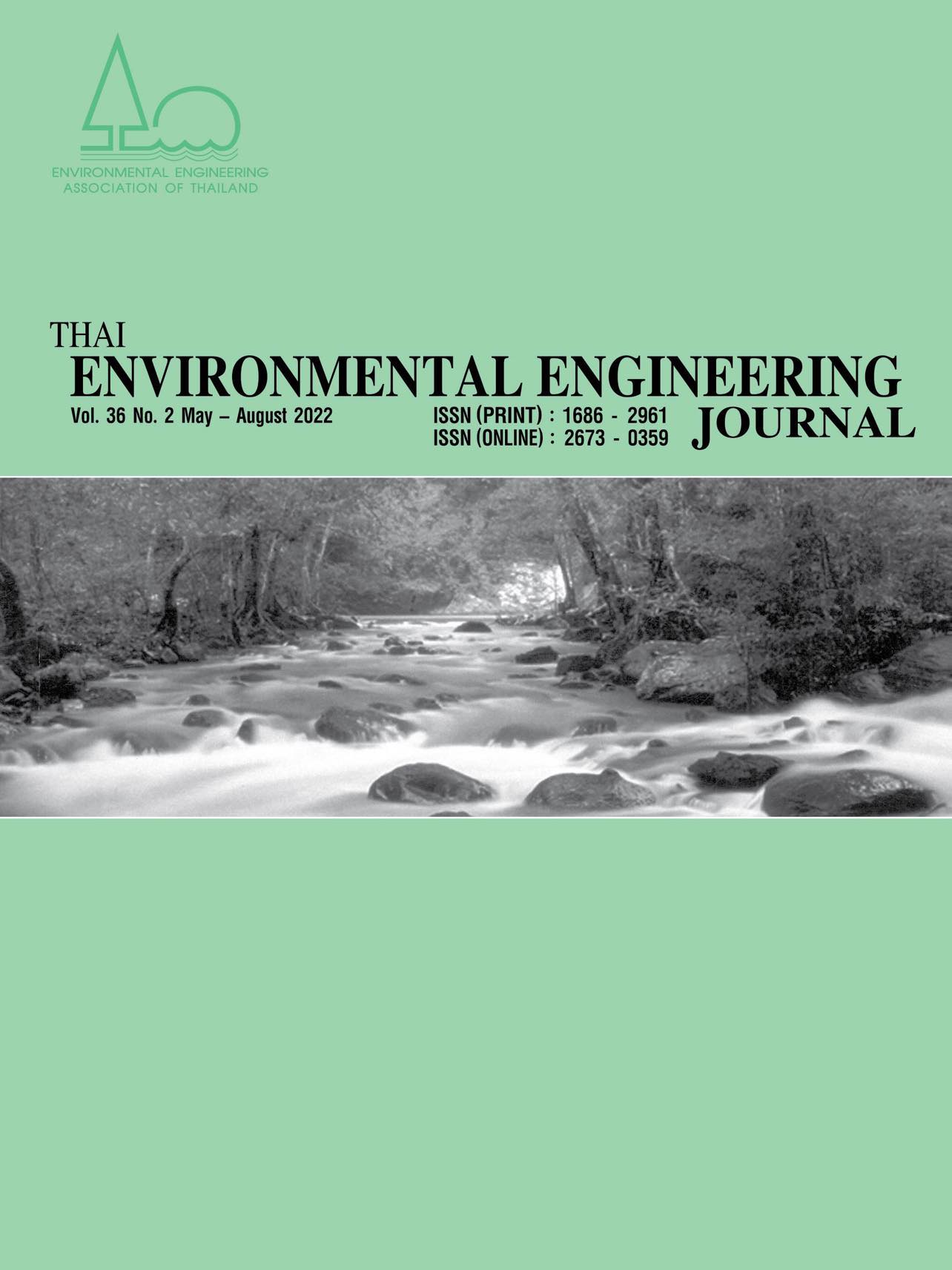Removal of Turbidity, COD and Coliform Bacteria in Duck-Pond Water by Hydroponic Water Convolvulus Gardening
Main Article Content
Abstract
The objective of this research is to investigate the performance of hydroponic water convolvulus gardening in the removal of turbidity, COD, and coliform bacteria from duck-pond water. The experiment was done using 2 hydroponic gardening sets in the condition of 5-day HRT and 7-day HRT separately for a 42-day operation. The results showed that removal efficiencies were 89.39 ± 7.73% for turbidity and 77.48 ± 11.25% for COD at the 5-day HRT, and were 91.79 ± 6% for turbidity and 75.01 ± 18.41% for COD for the 7-day HRT. And removal efficiencies of total coliform bacteria and E. coli were 87.0 ± 15.3% and 94.5 ± 13.6% for 5-day HRT operation, and 81.5 ± 11.7% and 99.8 ± 0.5% for 7-day HRT operation. According to t-test results at the confidence level of 95%, the system showed no difference in removal efficiencies at both HRTs. The effluent from the systems had turbidity and COD in ranges of 5.52-40.10 NTU and 4.77-81.60 mg/L, respectively which passed the quality standard of effluent from the domestic wastewater treatment. Due to the surface water quality standard, total coliform bacteria and E. coli concentrations of the effluent were in the range of 0-31.8 CFU/100ml which could be used for full-body contact. However, the water convolvulus grown in the hydroponic systems should be well washed and inspected for residual bacteria before eating due to its high level of fecal coliforms (240 to 930 MPN/g).
Article Details
References
Chankaew, P. 2021. Unleash the ducks! Thai drought worries threaten farming tradition,” Reuters, 2020 Accessed: Apr. 18, 2021 [Online]. Available: https://www.reuters.com/article/thailand-ducks/unleash-the-ducks-thai-drought-worries-threaten-farming-tradition-idINKBN26610S.
Waitt, C., Jones, T. and M. Dawkins. 2009. Behaviour, synchrony and welfare of Pekin ducks in relation to water use. Applied Animal Behaviour Science. 121(3): 184-189.
Soliman, K.A., El-Horbeety, A.A.A., Essa, M.A.R., Kosba, A.M. and Kariony, A.I. 2000. Effects of introducing ducks into fish ponds on water quality, natural productivity and fish production together with the economic evaluation of the integrated and non-integrated systems. Aquaculture International. 8(4): 315-326.
Sri Lakshmi, K., Hema Sailaja, V. and Anji Reddy, M. 2017. Phytoremediation - A Promising Technique in Waste Water Treatment. International Journal of Scientific Research and Management (IJSRM). 5(6): 5480-5489.
Lu, J., Fu, Z. and Yin, Z. 2008. Performance of a water hyacinth (Eichhornia crassipes) system in the treatment of wastewater from a duck farm and the effects of using water hyacinth as duck feed. Journal of Environmental Sciences. 20(5): 513-519.
Pongthornpruek, S. 2017. Swine Farm Wastewater Treatment by Constructed Wetland Planted with Vetiver Grass. Environment and Natural Resources Journal. 15(2): 13-20.
Thailand Regional Environmental Office 5. 2021. The water convolvulus management manual. Accessed: Nov. 26, 2021 [Online]. Available: http://lib.mnre.go.th/book/paktob.pdf.
Fahim, R., Lu, X., Jilani, G., Hussain, J. and Hussain, I. 2019. Comparison of floating-bed wetland and gravel filter amended with limestone and sawdust for sewage treatment. Environmental Science and Pollution Research. 26(20): 20400-20410.
Nguyen, T.V.D., Huynh, H.N.T., Nguyen, M.N.H. and Ngo, T.V. 2018. The use of water spinach (Ipomoea aquatica) in domestic wastewater treatment. The Journal of Agriculture and Development. 17(3): 49-54.
U.S. Environmental Protection Agency (EPA). 1993. Method 180.1 Determination of Turbidity by Nephelometry. Accessed: Nov. 26, 2021 [Online]. Available: https://www.epa.gov/sites/default/files/2015-08/documents/method_180-1_1993.pdf.
U.S. Environmental Protection Agency (EPA). 1978. Method 410.3: Chemical Oxygen Demand (Titrimetric, High Level for Saline Waters) by Titration). Accessed: Nov. 26, 2021 [Online]. Available: https://www.epa.gov/sites/default/files/2015-08/documents/method_410-3_1978.pdf.
Mizuochi, S., Nelson, M., Baylis, C., Jewell, K., Green, B., Limbum, R., Fernandez, M.C., Salfinger, Y. and Chen, Y. 2016. Matrix Extension Study: Validation of the Compact Dry EC Method for Enumeration of Escherichia coli and non-E. coli Coliform Bacteria in Selected Foods. Journal of AOAC International. 99(2): 451-450.
Food and Drug Administration (FDA). 2020. Chapter 4: Enumeration of Escherichia coli and the Coliform Bacteria. Bacteriological Analytical Manual (BAM), October 2020. Accessed: Nov. 26, 2021 [Online]. Available: https://www.fda.gov/food/laboratory-methods-food/bam-chapter-4-enumeration-escherichia-coli-and-coliform-bacteria.
Dhir, B. 2020. Effective control of waterborne pathogens by aquatic plants. Waterborne Pathogens. 2020: 339-361. Accessed: June. 5, 2022 [Online]. Available: https://www.ncbi.nlm.nih.gov/pmc/articles/PMC7173607/pdf/main.pdf.
Sanders, E.C. and Yuan, Y. 2013. Fecal Coliform and E. coli Concentrations in Effluent-Dominated Streams of the Upper Santa Cruz Watershed. Water 2013. 5(1): 243-261.
Thai Government. 1994. Notification of Thailand National Environmental Board, No. 8, B.E. 2537 (1994). Royal Thai Government Gazette. 111 Part 16: B.E. 2537.
Benti, G., Kebede, A. and Menkir, S. 2014. Assessment of bacteriological contaminants of some vegetables irrigated with Awash River water in selected farms around Adama town, Ethiopia. Journal of Microbiology and Antimicrobials. 6(2): 37-42.


